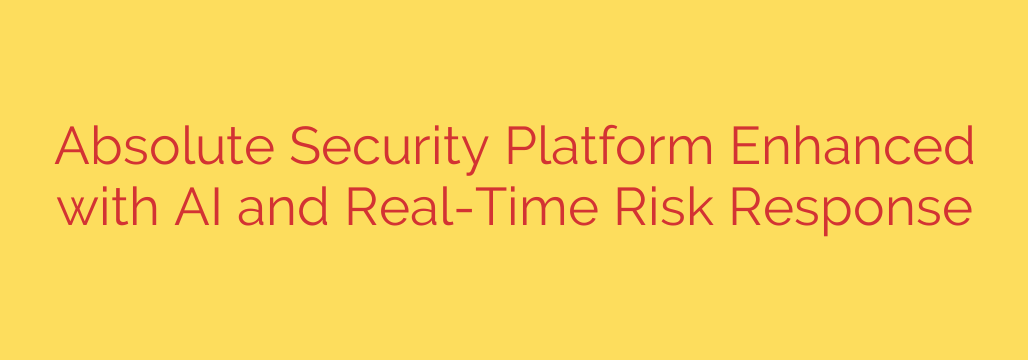
The Future of Cybersecurity: How AI is Powering Real-Time Endpoint Protection
In today’s complex digital landscape, the security perimeter is no longer the office wall—it’s every single laptop, desktop, and mobile device your organization uses. With the rise of remote work and increasingly sophisticated cyber threats, protecting these endpoints has become a monumental challenge. Traditional security methods that rely on manual intervention and reactive measures are simply too slow to keep up.
The next evolution in cybersecurity is here, and it’s driven by Artificial Intelligence (AI) and the power of real-time response. Modern security platforms are now leveraging AI to move from a reactive to a proactive defense strategy, stopping threats before they can cause significant damage.
The Challenge: A Growing and Vulnerable Attack Surface
Every device connected to your network is a potential entry point for attackers. Managing and securing this sprawling, distributed fleet of endpoints is a constant battle for IT and security teams. They face several key problems:
- Alert Fatigue: Security tools generate thousands of alerts daily, making it impossible for human teams to investigate every single one. Many critical threats get lost in the noise.
- Delayed Response: By the time a threat is identified, manually investigated, and remediated, an attacker may have already been in the network for hours or even days.
- Sophisticated Attacks: Modern malware and ransomware are designed to evade traditional signature-based detection and disable security controls.
The Game-Changer: Integrating AI into Security
This is where AI transforms the equation. By integrating AI and machine learning directly into a security platform, organizations gain the ability to analyze vast amounts of data from every endpoint in real time. This creates a smarter, more resilient defense system.
Key advantages include:
- Predictive Threat Detection: Instead of waiting for an attack to happen, AI can analyze device behavior, application data, and network telemetry to identify patterns that signal a potential compromise. It learns what “normal” looks like for your organization and can instantly flag suspicious deviations.
- Intelligent Risk Assessment: AI provides a dynamic, real-time understanding of your organization’s risk posture. It can identify which devices are most vulnerable—due to unpatched software, risky user behavior, or disabled security controls—allowing teams to prioritize their efforts on the most critical issues.
- Automated Investigations: AI significantly reduces alert fatigue by automatically analyzing and contextualizing security alerts. It can distinguish between false positives and genuine threats, freeing up security analysts to focus their expertise on high-level incidents.
From Detection to Action: The Power of Real-Time Response
Identifying a threat is only half the battle. The true power of a modern security platform lies in its ability to respond immediately and automatically. When every second counts, automated, real-time remediation is essential to containing a breach.
Here’s how it works in practice:
- Context-Aware Policies: The system can enforce dynamic security policies based on risk. For example, if a device suddenly exhibits high-risk behavior (like trying to connect to a malicious server), it can be automatically quarantined from the network until the issue is resolved.
- Automated Remediation: If a critical security application (like an antivirus or encryption tool) is disabled or not working correctly, the platform can automatically repair or reinstall it. This ensures your security controls are always active and effective.
- Self-Healing Endpoints: The most advanced platforms offer a tamper-proof, self-healing connection embedded in the device’s firmware. This ensures that even if a device’s operating system is compromised or its hard drive is wiped, the security agent can regenerate itself, maintaining visibility and control.
Actionable Steps to Bolster Your Security Posture
Moving toward an AI-driven security model is a strategic imperative for modern businesses. Here are a few key tips to enhance your organization’s resilience:
- Prioritize Endpoint Visibility: You cannot protect what you cannot see. Ensure you have a persistent, unbreakable connection to every endpoint, regardless of its location or network status.
- Adopt a Zero Trust Mindset: Assume no user or device is inherently trustworthy. Continuously verify identity, device health, and context before granting access to resources.
- Leverage Automation: Free your IT and security teams from repetitive, manual tasks. Use automation to handle patching, policy enforcement, and initial incident response so your experts can focus on strategic initiatives.
- Invest in Resilience: Your security tools are a primary target for attackers. Choose solutions that are self-healing and can withstand attempts to disable or remove them.
By embracing these principles and leveraging the power of AI, organizations can build a more intelligent, responsive, and resilient defense capable of protecting them against the threats of today and tomorrow.
Source: https://www.helpnetsecurity.com/2025/08/06/absolute-secure-endpoint-10-innovations/








